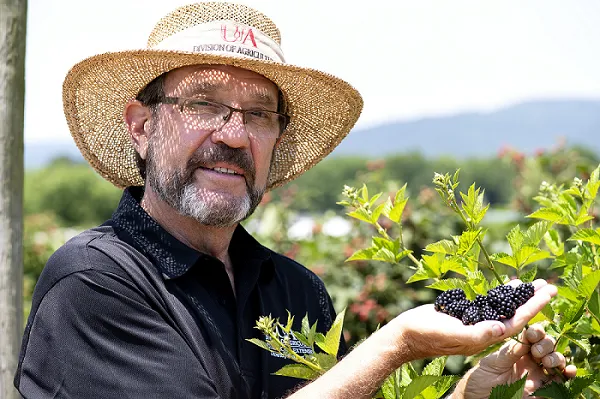To celebrate National Arkansas Day on January 11, USDA’s National Institute of Food and Agriculture (NIFA) highlights the innovative NIFA-funded research conducted by the University of Arkansas System Division of Agriculture’s Arkansas Agricultural Experiment Station.

Historical Background
The Arkansas Agricultural Experiment Station was formally established in 1888 following the passage of the Hatch Act of 1887, which provided federal funding to assist in the operation of state-based agricultural experiment stations by Land-grant Universities. The University of Arkansas Board of Trustees had jump-started the process in May 1886 by inaugurating scientific experiments in agriculture and horticulture on university property.
A huge step forward for agricultural research in Arkansas came with the creation of the Division of Agriculture in 1959 as a separate institution within the University of Arkansas System. Responsibility for experiment station research and Cooperative Extension Service educational programs was transferred from the Fayetteville campus to the new statewide campus, allowing for concentrated focus on the state’s largest industry.
With this arrangement, the spirit of the agricultural land-grant mission in Arkansas of teaching, research, and Extension became shared between the new Division of Agriculture and the University of Arkansas and other campuses. Since 1959, there has been an intertwining in both practice and impact, with many experiment station research scientists holding Extension appointments and serving on the teaching faculty at university campuses.
Successes and Innovations
Vitamin E co-discovery — Barnett Sure, an agricultural chemist, joined the experiment station in 1920 and received international attention through his work in nutrition and vitamins. Sure became a co-discoverer of vitamin E.
Pesticide granules — Fred E. Whitehead, entomology researcher for the experiment station, was one of the first researchers to emphasize the potential environmental dangers of pesticides. He developed the process of using granular particles as carriers of pesticides, which was adopted widely by the pesticide industry.
Scouting for pests — Dwight Isely, entomologist for the experiment station from 1921-1956, was one of the first researchers to take a statistical approach to scouting for insect pests to time application of insecticides.
Biological mycoherbicides for field crops — The first commercially available mycoherbicide to control weeds in an agronomic crop — Collego — was co-developed by plant pathologist George Templeton after a dozen years of research and development. It became a model for research on development of biological weedkillers around the world.
Poultry vaccine technology — Billy Hargis, poultry science professor and director of the John Kirkpatrick Skeeles Poultry Health Laboratory, co-developed a patented animal vaccine technology platform for economically important pathogens such as Salmonella, Eimeria and avian influenza. This technology led to the announcement of a new manufacturing and business development by Pacific GeneTech in 2022.
Arkansas rice breeding program — The genetic gains made by the Arkansas rice breeding program added approximately 4.16 million more metric tons of a critical staple grain — rice — to the global food supply. The Division of Agriculture released four new rice varieties in 2022, including its latest aromatic rice, ARoma 22, which represents a step change in quality for Southern Jasmine rice.

Primocane Blackberries — John R. Clark, Distinguished Professor of horticulture, has become world-renowned for fruit breeding. Building on work started by fruit breeder James N. Moore, Clark took a lead role in developing the first primocane-fruiting commercial blackberry cultivars Prime-Jan® and Prime-Jim® in the late 1990s. Primocane-fruiting blackberry cultivars extend the blackberry fruiting season, giving consumers and producers the ability to enjoy blackberries well into late summer.
NIFA-Funded Research
Agriculture is Arkansas’ largest industry, contributing about $19 billion in value added in 2020. Agriculture represents approximately 243,000 jobs — one out of every seven jobs in Arkansas — and $12.1 billion in labor income. Accordingly, agriculture and food research are critical to helping this vital and growing component of the state’s economy.

NIFA funded research allows the Arkansas Agricultural Experiment Station to address critical challenges that Arkansas’ largest industry faces. Through NIFA funding, Fiona Goggin, professor of entomology at the experiment station, has been investigating new approaches for controlling nematodes, which caused more than $95 million in damage to soybean crops in 2021; Sara Orlowski, a poultry science researcher working as part of a five-year, multi-institution project funded by a $9.9 million NIFA grant, is searching for a more water-efficient chicken; and Kristen Gibson, professor of food safety and microbiology, was awarded a nearly $1 million NIFA rapid response grant to investigate the real-world persistence of the virus that causes COVID-19, SARS-CoV-2.
These NIFA-funded research projects and more help address the needs of Arkansans and beyond.
Unique Agricultural Challenges
The Arkansas Agricultural Experiment Station is committed to solving the problems that matter to Arkansans through a holistic mindset and collaborative research on the state, regional and national levels.
Unique challenges for Arkansas researchers include developing disease-resistant plants, as well as biological controls and methods to offset growing herbicide and pesticide resistance. With aquifer depletion in east Arkansas, where a majority of the state’s soybean, cotton, rice and corn is grown, experiment station scientists are focused on water-saving technologies and developing soybeans that can adapt to the effects of climate change. Reducing greenhouse gases in rice production and nutrient runoff from poultry production are also a focus. Arkansas animal scientists are even breeding chickens to be more water efficient.
Scientists are continuously looking for ways to help farmers be more efficient, more sustainable and more profitable. From below ground where it all begins to high in the air with drone technology, and from dynamic agricultural commodities markets to farmers markets, Arkansas scientists are helping to strengthen food systems, conserve resources and develop new best practices.

Arkansas, like much of the rest of the world, is facing new and pressing challenges. NIFA funding helps Arkansas scientists conduct research and make discoveries that expand agricultural sustainability and profitability, promote environmental stewardship, strengthen local and state economies and ensure a safe and nutritious food supply.
Top image: United States of America lights during night as it looks like from space. Image courtesy of Adobe Stock.

